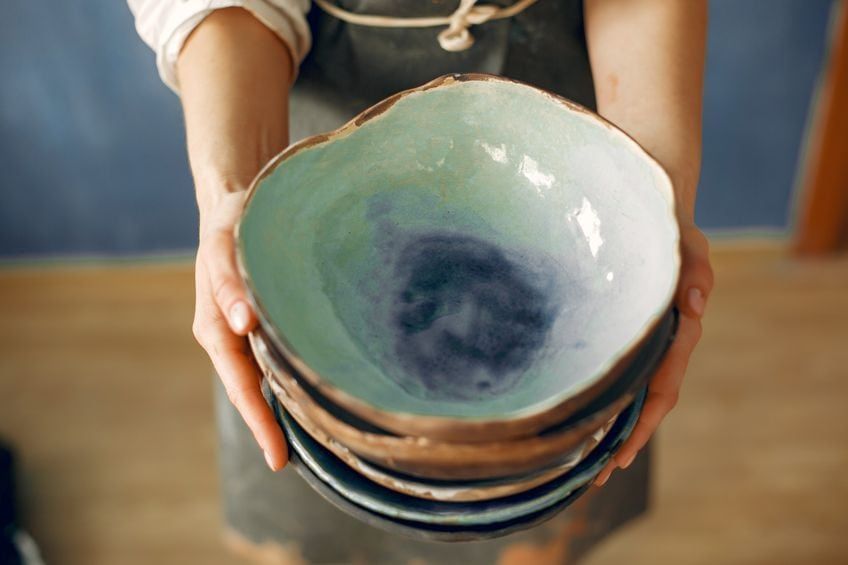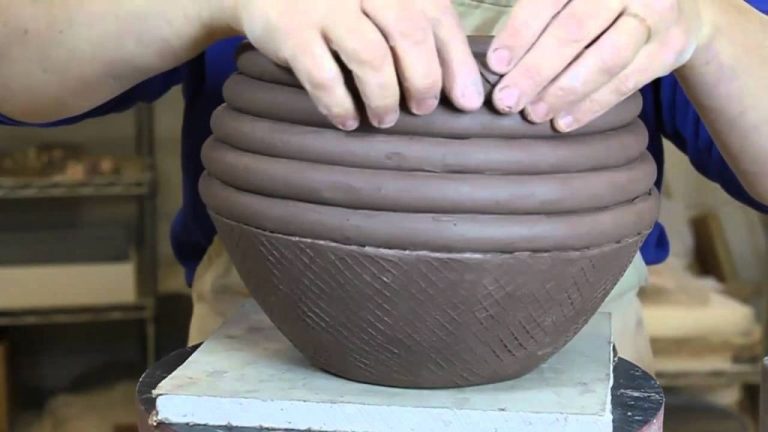Which Paint To Use On Pot?
When choosing paint for pottery, there are several key factors to consider including the firing temperature, type of clay, desired color and special effects, toxicity, application method, and maintenance. The right type of paint depends on whether the pottery is fired, the clay body composition, and the desired end result. Selecting appropriate paint and application techniques helps create beautiful, durable pottery.
This guide will provide an overview of the core considerations when selecting paint for ceramic pots and other pottery pieces. It will cover the differences between paint types, firing needs, clay compatibility, colors and finishes, toxicity concerns, application techniques, sealing requirements, and care. With the right information, potters can confidently choose the ideal paint for their projects.
Firing Temperature
When selecting a paint for pottery, one of the most important considerations is the firing temperature. Pottery paints are formulated to be fired at either low temperatures (under cone 04) or high temperatures (cone 4-10). Low fire paints contain fluxes and minerals that melt and bond at lower temperatures, while high fire paints are more durable and can withstand the high heat of stoneware and porcelain firings.
Low fire paints are often brighter and more vibrant when first fired, but they are less permanent and durable over time. High fire paints produce more muted earthy tones but hold up better to repeated use and cleaning. According to an article on Crafty Chica, high fire ceramics tend to be stronger, more durable, and more water-resistant compared to low fire pieces.
On reddit discussions, many potters recommend using high fire paints whenever possible for functional pottery that will be used repeatedly. High fire paints are better able to withstand wear and tear. For non-functional decorative pieces that will not be handled often, low fire paints can provide beautiful results. When selecting a paint, consider the clay type, firing temperature, and intended use of the finished piece.
Type of Clay
The type of clay used for pottery will impact what paint works best. There are three main types of pottery clay – stoneware, earthenware, and porcelain. Stoneware is dense, non-porous clay that is fired at a high temperature. It holds paint well and does not require sealing before painting. Acrylic and enamel paints work best on stoneware (source).

Earthenware is porous, low-fire clay. It requires sealing before painting so the paint does not soak in. Acrylic paint works well on sealed earthenware. Porcelain is very refined, translucent clay fired at a high temperature. It can be tricky to paint and requires high-temperature specialty paints. In general, stoneware and porcelain work best with acrylic and enamels, while sealed earthenware pairs well with acrylics.
Type of Paint
When choosing a paint for pottery, the three main options are acrylics, oils, and enamels. Each has their own advantages and disadvantages to consider:
Acrylic paints are water-based and quick-drying. They are easy to clean up with water and good for beginners. Acrylics adhere well to bisqueware and greenware. However, they can appear flat and lack the richness of oils. Acrylics also become permanent once dry and can’t be reworked. Popular brands include Liquitex and Craft Smart.
Oil paints are slower-drying, allowing more time for blending. They produce a luminous, glossy finish. However, oils require solvents to thin and clean up. Oils also take much longer to fully cure. Gamblin and Winsor & Newton are quality oil paint brands. Oils work best on finished, glazed pieces.
Enamel paints contain petroleum solvents and harden into a glass-like finish. They are durable and chip-resistant. Enamels work on greenware and bisqueware. However, they have a strong odor and can bubble or crack if not fired properly. Duncan and Delta Ceramcoat are popular enamel brands.
For most beginner pottery painting, acrylics provide the easiest, most versatile option. Oils create a richer effect for advanced techniques. Enamels are ideal for adding durable color to functional ware.
Color
When choosing colors for painting ceramic pottery, one of the main considerations is whether to use opaque or transparent paints. Opaque paints contain pigments suspended in a binder that obscures the surface underneath, while transparent paints allow the underlying surface to show through.
Opaque paints like acrylics provide complete coverage and vivid, intense colors. They work well for solid backgrounds and details. Transparent paints like watercolors allow more subtle effects as layers build up color gradually. Glazes are transparent, providing depth and luminosity from the underlying fired surface.
For most ceramic painting, a mix of opaque and transparent paint works best. Opaque paint can provide bold color for the main design. Then transparent glazes over top can blend and soften the opaque colors. Using both creates visual interest and a sense of depth on the pottery surface.1
Special Effects
Beyond just adding color, there are many special effect paints that can create unique looks on pottery. Some popular options include:
Metallic Paints – These contain tiny metallic particles, usually made of precious metals like silver, gold, copper or bronze. Metallic paints create a shiny, gleaming finish. They are best used over a dark underglaze or slip.
Glow in the Dark – As the name suggests, these paints absorb light when illuminated and later emit a phosphorescent glow when the lights go out. The glow effect can last for several hours but is not extremely bright. Multiple coats will intensify the effect.
Crackle Glaze – Crackle paints or glazes form a network of cracks as they dry, giving an aged or weathered look. The cracks allow the underlying clay color to show through. Crackle intensity varies based on thickness and firing temperature.
Iridescent – These paints contain mica particles that refract light and create a pearlescent, iridescent effect. The shine appears to change color depending on the viewing angle.
There are many more special effect options to explore, like ombre glazes, bubbly textures, misty finishes and more. The choices available can help create truly one-of-a-kind pottery works.
Toxicity
When choosing paint for pottery that will be used for food or drink, it’s important to consider toxicity. Some paints contain lead, cadmium and other heavy metals that can leach into food and beverages, posing a health risk.
There are two main options when it comes to paint toxicity for ceramic pots:
-
Food Safe Paints – These paints are free of lead, cadmium and other toxic metals and are formulated to be non-toxic. They are safe to use on ceramic pieces that will come in contact with food and drink. Food safe ceramic paints are widely available from art supply stores.
-
Non-Food Safe Paints – These paints may contain toxic ingredients like lead and cadmium that can leach into food and drinks. They should only be used on ceramic pieces that are purely decorative and won’t be used for food purposes. While vibrant, non-food safe paints do carry risks.
When in doubt, it’s best to opt for food-safe ceramic paints to avoid any health hazards. Read the label and product information closely to ensure the paints you choose are non-toxic and FD&C compliant.
Application Method
When applying paint to pottery, you have three main options for application methods: brush, sponge, or spray.
Using a brush allows you to have the most control and precision when painting details or designs. Brush strokes also create an artistic, hand-painted look. Synthetic brushes like nylon or polyester tend to work better than natural bristles. Make sure to use soft brushes that won’t scratch the bisqueware surface. Gentle, even brush strokes work best for smooth coverage.
A sponge can be used to apply broad areas of color smoothly and evenly. Sponges create a mottled texture and softened edges. Cut a craft sponge into a shape (like a square edge) and apply paint in a dabbing motion. Sponges work especially well for blending colors together.
With spray paint, you can cover large areas quickly and evenly. Spray in light coats, allowing each layer to dry first. Mask off any areas you don’t want painted. Spray paint allows you to create ombré gradients and blended effects. Use spray paints formulated for pottery. Work in a ventilated area and avoid breathing the vapors.
So in summary: Brushes for detail and control, sponges for blending and textures, spray for large areas and special effects. Consider the needs of your particular pottery project when selecting an application method.
Sealing
Sealing painted terracotta pots is an important step to protect the finish and make it more durable. There are a few options when it comes to clear sealing products for pottery:
Polyurethane is a common sealant for painted ceramics. It creates a plastic-like coating that is waterproof and protective. Apply 2-3 thin coats of water-based polyurethane with a foam brush and allow to fully dry between coats for best results. Source
Acrylic sealers are another good choice for sealing painted pots. Look for an acrylic sealer formulated for ceramics and follow the manufacturer’s instructions for application. Acrylics dry quickly and provide a durable, water-resistant finish. Allow the paint to cure fully before applying the acrylic sealer.
Clear glazes formulated for low-fire ceramics can also seal and protect painted terracotta. Apply the glaze with a brush and fire the pottery according to the temperature guidelines on the glaze package. Multiple thin layers of glaze tend to work better than one thick coat. Firing will make the paint and glaze permanent.
Wax sealants like paste wax can provide shine and moderate protection for painted pots used outdoors. Wax will need to be reapplied periodically as it wears off over time. Apply wax with a soft cloth and buff to a sheen after drying.
Maintenance
Properly caring for painted pottery is crucial to maintaining its beauty and integrity over time. Handwashing painted pieces with mild soap and water is recommended over dishwasher cleaning, which can damage the paint. Allow pieces to fully cool before washing to prevent cracking. Use a soft sponge or cloth when handwashing, avoiding abrasive scouring pads. Be gentle when cleaning painted areas.
For tougher stains on painted pottery, make a cleaning paste with baking soda and water and gently rub stained areas with a soft cloth or toothbrush. Rinse thoroughly afterwards. Avoid soaking pottery for long periods, as moisture can damage paint over time. Let pieces air dry fully before storing. With proper care, beautifully hand-painted pottery can remain vibrant and intact for years to come.



